Final day of the three day tour. The plan for the day was to focus on the Titchwell area, and with the flow of drift migrants over the last few days drying up a little, finally to find the time to focus on waders and some other regular species. What we didn’t expect to get was a couple of extra surprises on the way!
As we walked out along the main footpath, we stopped to look at a smart Grey Plover out on the saltmarsh. A glance behind us, and a glimpse of a tail dropping into the reeds looked promising for a Bearded Tit. It was just beside the path, so we waited quietly. A couple of calls confirmed the identification, but we couldn’t see it at first, until some rustling of the reeds revealed a female. We managed to get the scope on it and suddenly a male edged up from below. Great views! We watched the pair of Bearded Tits for several minutes, disappearing down into the reeds, then climbing up again; flying a short distance, dropping in and then reappearing again. All at close quarters, just by the main path.
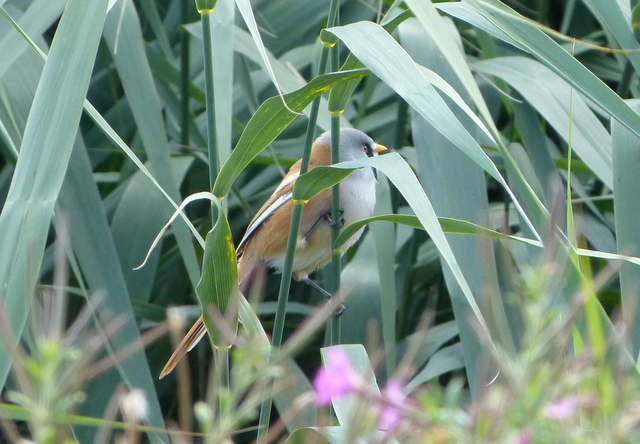 Bearded Tit – a pair gave great views close to the main path
Bearded Tit – a pair gave great views close to the main path
As we walked on, we could see 4 Spoonbills out on the saltmarsh on the Thornham side. We stopped in the Island Hide next, and the freshmarsh was covered with waders. Scanning through the massed ranks of Dunlin, we quickly picked up a couple of juvenile Curlew Sandpipers out in the deeper water, probing down with their longer decurved bills. On the edge of the group, feeding up on the mud itself, a much smaller wader stood out – a juvenile Little Stint. As we watched them, the flock worked their way over towards the main path, so we decided to leave the hide and walk on a little further to view them from there.
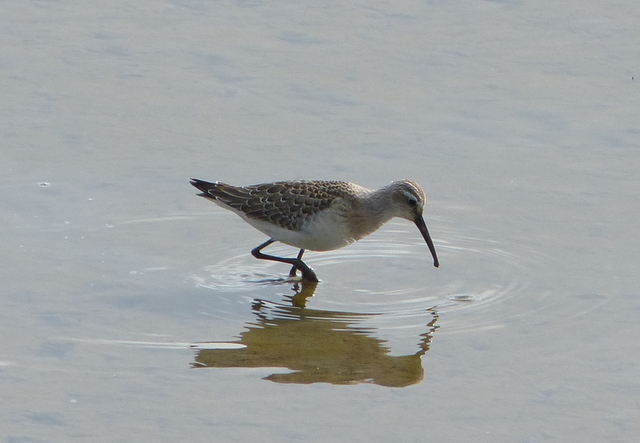 Curlew Sandpiper – at least 9 juveniles were on the marsh today
Curlew Sandpiper – at least 9 juveniles were on the marsh today
As we walked, more Curlew Sandpipers flew in from out on the freshmarsh, and eventually we counted 9 juveniles amongst the Dunlin. As we got closer, we found there were also now 3 juvenile Little Stints. All of the waders were feeding in the water right next to the path – much closer than normal – allowing us to get really great up-close views.
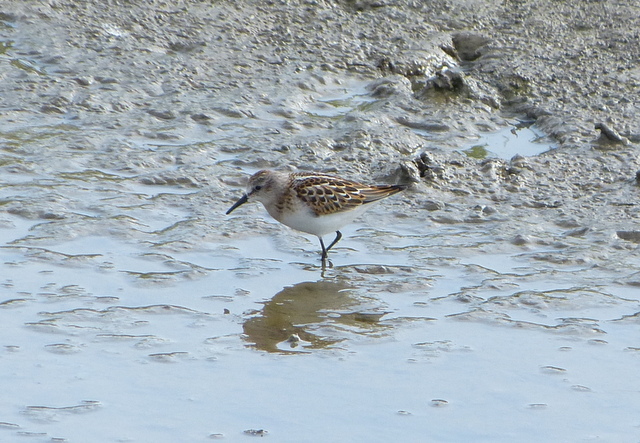 Little Stint – 3 of these tiny waders were feeding on the mud right next to the path
Little Stint – 3 of these tiny waders were feeding on the mud right next to the path
While we were watching them, a single Yellow Wagtail circled overhead calling, but wouldn’t come down with all the Pied Wagtails. Amongst all the excitement, it was easy to forget all the other waders we had seen out on the freshmarsh – Avocets, Lapwing, Snipe and lots of Ruff, in various different plumages; Black-tailed Godwits and Curlew; at least 6 Spotted Redshank, lots of Redshank and a couple of Greenshank. Quite a list. At the Volunteer Marsh, we stopped to watch a Black-tailed Godwit feeding, probing its long bill right down into the deep mud and leaving both it and its face covered. A little further out, a couple of Bar-tailed Godwits provided a great opportunity to compare and contrast.
The tide was out and on the beach,we added a whole load more waders to the list for the day. On the tideline, there were lots of Oystercatcher, loads more Grey Plover, a couple of Knot, a group of Sanderling and several Turnstone. Out on the sea, a lone male Eider in eclipse plumage drifted by and several Fulmars flew past. We also spent some time discussing the identification of the commoner large gulls and looking at the terns offshore.
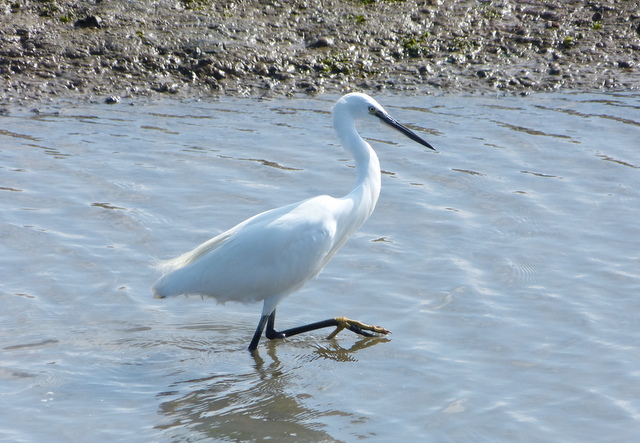 Little Egret – this bird was feeding on the edge of the Volunteer Marsh today
Little Egret – this bird was feeding on the edge of the Volunteer Marsh today
We called in at the Parrinder Hide on the way back. Several of the Spoonbills had flown back from feeding out on Thornham marsh and were now roosting on the freshmarsh. We counted 10 initially, but as we watched a further 3 flew in and dropped down amongst them. Most of the waders, we had seen from the footpath, but a small group of Golden Plover were new. However, the real surprise was a Pink-footed Goose which appeared amongst the Greylags. It may be one of the small number of birds from Holkham which don’t make the journey back to Iceland, either due to illness or possibly immaturity. However, we are already getting into the period for the first returning birds, so perhaps winter is on its way already!
 Lapwing – feeding right outside the Parrinder Hide
Lapwing – feeding right outside the Parrinder Hide
After lunch in the picnic area, enjoying the now warm and sunny weather, we headed back out onto the reserve to have a look at Patsy’s Reedbed. We spent some time watching a Kingfisher, which perched up on the posts around the planted reeds. It splashed into the water numerous times without reward, before finally emerging with a whopper of a fish. Back on one of its favourite posts, it proceeded to beat the fish against it numerous times until it finally felt confident enough to swallow it. It then sat looking rather uncomfortable after its enormous meal for a couple of minutes afterwards. We had so far failed to find any of the resident Red-crested Pochard, but after searching through the flocks of duck to no avail, suddenly a bright, day-glo red bill appeared amongst the vegetation on one of the islands as an eclipse drake which had been sleeping finally awoke.
We ended the day exploring the area around Choseley. The footpath at the drying barns was rather quiet, perhaps due to too many dog walkers on a sunny Sunday afternoon, until a Marsh Harrier appeared over the fields. It seemed to be mobbing something, which would normally be the wrong way round, but then a Short-eared Owl appeared from behind a hedge. The two circled up, the owl trying to get above the harrier, and came right overhead before drifting off. Short-eared Owl is mainly a winter visitor to Norfolk, though the odd pair may still breed in remoter areas, so this sighting was totally unexpected and most unusual.
 Short-eared Owl – normally a winter visitor, this bird circled over Choseley this afternoon pursued by a Marsh Harrier
Short-eared Owl – normally a winter visitor, this bird circled over Choseley this afternoon pursued by a Marsh Harrier
Before the tour started, on the way to Titchwell, several Whinchats had appeared by the road just south of Choseley, obviously migrants which had started to work their way inland. So we finished the day headed on down the road a little further. After looking in a couple of likely fields, we found a grand total of 4 Whinchats feeding around a hedge on the edge of a set-aside field corner. A nice way to end the tour, with one of the migrants which has featured so often across the last three days.
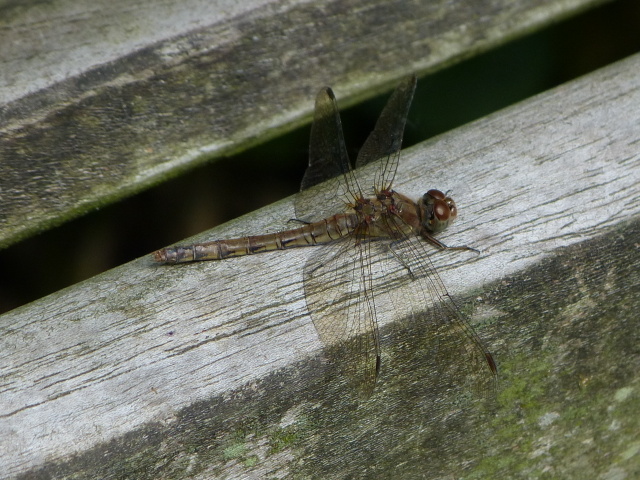 Common Darter – still a few dragonflies are on the wing; this one decided to rest on a bench
Common Darter – still a few dragonflies are on the wing; this one decided to rest on a bench
















